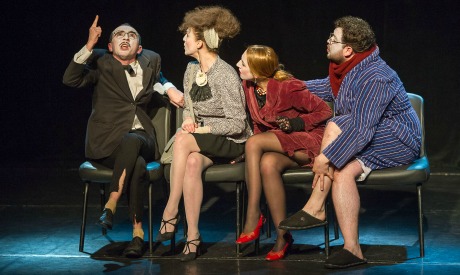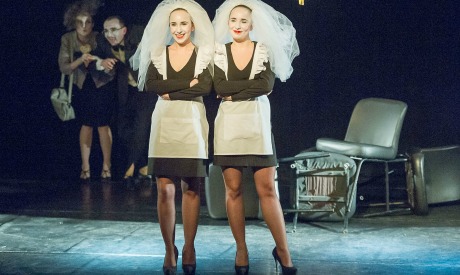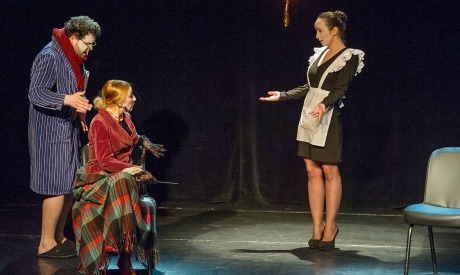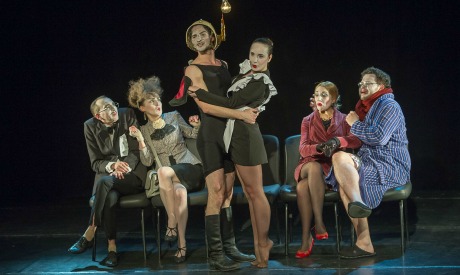Organised by the Bibliotheca Alexandrina’s Arts Centre, the second edition of the Alexandria International Festival for Contemporary Theatre took place 5-10 April, offering an assortment of plays from Egyptian and international troupes.
Though the festival’s programme enumerated 11 performances worth attending, one of them instantly grabbed my attention: The Bald Soprano, by my all times favourite, Eugene Ionesco. And when I realised that the troupe performing this anti-play was the Eugene Ionesco Theatre (Teatrul Eugene Ionesco) from Chișinău, capital of the Republic of Moldova, my preliminary light interest soon turned into a “Must see” state of mind.
Expectations were high. No wonder, the play came to Alexandria with the presumed specialists of Ionesco, a troupe that has in its repertoire many of his plays, alongside works by Samuel Beckett, Alfred Jarry, Matei Vişniec, Brian McAvera, a performance based on poetry by Eugen Cioclea, among many other interesting offerings.
Moldova’s Ionesco Theatre was launched back in 1991 with the opening play being precisely The Bald Soprano directed by Petru Vutcărău, an iconic performance in its own right whose success made it tour the world. The Bald Soprano, which came to Alexandria this month, however, was yet another take on the play, directed by Slava Sambriș and premiered in 2015. Going back to the first performance staged by this theatre — and Ionesco’s first acclaimed work — the troupe celebrates its silver anniversary.
An iconic text that was born in the hands of a Romanian-French playwright while studying English language, The Bald Soprano (also known as The Bald Prima Donna) became one of the most important theatre works of all time and since its premiere in 1950. And it has remained as fresh as if it was written yesterday, with all its meanings perfectly resonating in all social, political — and above all, human — contexts. Conceptually, The Bald Soprano is adaptable to all realities, and seems to be revalidated each time it is performed.

The Bald Soprano (Photo: Bassam Al Zoghby)
While this anti-play is among the world’s best known dramatic works, and one might expect it to be performed frequently, the play poses several challenges to the director in the face of the expectations of today's audiences. On the one hand, with such an acclaimed text, the weight of theatre aficionados hoping to see something different and unpredicted can be taxing. On the other hand, to many theatre practitioners who choose the dynamism of image over text, Ionesco might not be the most appealing choice. Equally, Ionesco’s text is a challenge for actors who usually find power in words — the basic element of transferring information in theatre — and are now required to deal with the language destruction and its absurdity.
We soon realise that with its futile dialogues, Ionesco’s play only seems simple. In the play we meet two couples — Mr and Mrs Smith and Mr and Mrs Martin — who converse about everything and nothing: boiled potatoes, a doctor who must die with his patient to prove conscientious, the ringing of a door bell as a debatable indication that someone is behind the door, etc. The quartet, which does not escape many memory lapses (Mrs Martin forgets who her husband was), is occasionally interrupted by a maid and an odd fire chief.
In brief, The Bald Soprano breaks all rules of communication known to classical theatre and stresses the destruction of language as a tool of verbal communion between human beings. To make the equation even more fascinating, there is no rising action, no actual plot, and as such no resolution. It is in The Bald Soprano that the playwright reduces our existence to two basic values: life and death. And it is here that lies Ionesco’s greatness, and his philosophy that was yet to take its full and often shocking shape in his later works.
When thinking about the text’s adaptability to current reality, virtual communication, the internet, the flood of voices in the media, all those representatives of broken human links, immediately come to mind. Hasn’t this concept become even more legitimate, more powerful today than when the play first saw daylight? When reaching the Bibliotheca Alexandrina’s small theatre, somehow, I thought about how this increased destruction of communication characterising the last two decades could have influenced the director, Slava Sambriș.

The Bald Soprano (Photo: Bassam Al Zoghby)
However, it came as a big and pleasant surprise when, for over one hour, the troupe took us back in time to a typical family living in the suburbs of London in the 1950s. And though the scenography is minimal, from the first minute the spectator understands that Sambriș chose to place Ionesco in his original setting. The spectator is introduced to the “middle-class English interior, an English evening, Englishman and Englishwoman, English silence and an English clock striking 17 English strokes,” exactly as Ionesco describes the setting in the script opening the text. The only physical reference to today's world is in music which, among many compositions, also includes some contemporary songs.
Sambriș proceeds by walking us through the play itself, respecting all dialogue and the playwright’s script. But not only does he remain faithful to the play and the script. He also, through this choice, goes deep into Ionesco’s core philosophy.
The actors hence move to further the destruction of an already broken communication through their intonation, or what we can refer to as “the melody of language.” Escaping monotonous narration in dialogue, the actors flirted with intonation that often completely contradicted the meanings pronounced. While doing so, they cut through the sheer molecules of words, reaching the most hidden layers of the spectator’s imagination.
And since words become the main protagonist of the play, Sambriș built a play around them with the characters becoming part of the playwright’s conceptual creation. In other words, Sambris' characters become engaging due to their distinctive personalities and not any ability of advancing the action.

The Bald Soprano (Photo: Bassam Al Zoghby)
Sambriș contrasts a talkative and hyperactive Mrs Smith (Inna Colbasiuc) with her husband, an indifferent and restrained Mr Smith (Laurentiu Vutcarau). The couple is joined by the snobbish Mrs Martin (Ana Jereghe) and a painfully bland, subdued Mr Martin (Dumitru Mamei). Using their personalities, Sambriș then builds the performance on a series of situational skits, each of which stresses the absurdity of the quartet’s behaviour. In all moments, the actors gave an outstanding performance, creating dozens of visually captivating images. Though each sculpted the core of each character, unveiling consecutive layers of each personality, it was the unique energy and focus on detail of Colbasiuc as Mrs Smith that left a strong impact on the viewer.
Mary, the maid, seems to be the most humane person in the whole play, one that still has emotions, dreams and hopes. Sambriș capitalised on this refreshing detail and as if wanting to strengthen the effect, he duplicated the character by introducing two identical actresses to play one role (twin sisters, Corina Butnaru and Mirabela Butnaru). Apart of having two separate bodies, both Marys act the same, move, gesticulate and talk together. Not without her own quirky attitude, the doubled Mary remains distanced from the dynamics of Ionesco’s couples.
As if becoming a different, and more subtle, reincarnation of Berenger (the protagonist of another, more complex Ionesco play, Rhinoceros), Mary does not give in to the Smiths/Martins' broken humanity. Yet unlike Berenger, instead of attempting to rescue them from themselves, she doesn’t even try to mingle with their failed existences.
Mary finds beauty in poetry and engages in a romantic relationship with the odd yet passionate fire chief (Anatoli Guzic). Their onstage affair culminates with the double Mary wearing wedding veils and dancing with her beloved. It is here that, without challenging the text, Sambriș plays a subtle game with Ionesco. He revolts against the playwright’s darkness, and infuses the performance with accents of humanity, creating an emotionally vivid contrast between the practically-dead quartet and the fire chief with his now beloved doubled Mary.

The Bald Soprano (Photo: Bassam Al Zoghby)
Moreover, Sambriș does not ignore the spectator. Again without undermining Ionesco’s text, the characters interweaved a few words in Arabic into the play, rendering it more accessible for an Egyptian audience. Though their inserts provoked strong laughter, they only deepened the absurdity of the language. Since language is no longer a tool of communication, why not give it a Tower of Babel effect and fuse all linguistic codes together?
In his interview with May Selim from Al-Ahram Hebdo, Sambriș revealed that he feared he would not be able to communicate with the Egyptian public. “The play is built on an absurd dialogue between the characters. I chose to insert into it technique known to the theatre of the grotesque, so as to additionally emphasise the daily absurdity,” he explained, adding how happy he was to find the Egyptian audience very receptive to the performance.
And indeed, though seemingly simple yet difficult in its structure, Ionesco’s play remains a challenge for the director, actors and the audiences alike. Performed in Romanian with English translation on the screen can only add to the confusion. It is by turning those very challenges into an engaging performance that testifies to the success of the play.
In today’s theatre, where many directors respond to the spectator's thirst for dynamic visual content, gaining the hearts of the audience with The Bald Soprano is a double success. This is also when we realise how true art, professional expertise, experience and reading deeply into a text can bring the most captivating results.

The Bald Soprano (Photo: Bassam Al Zoghby)
For more arts and culture news and updates, follow Ahram Online Arts and Culture on Twitter at @AhramOnlineArts and on Facebook at Ahram Online: Arts & Culture
Short link: